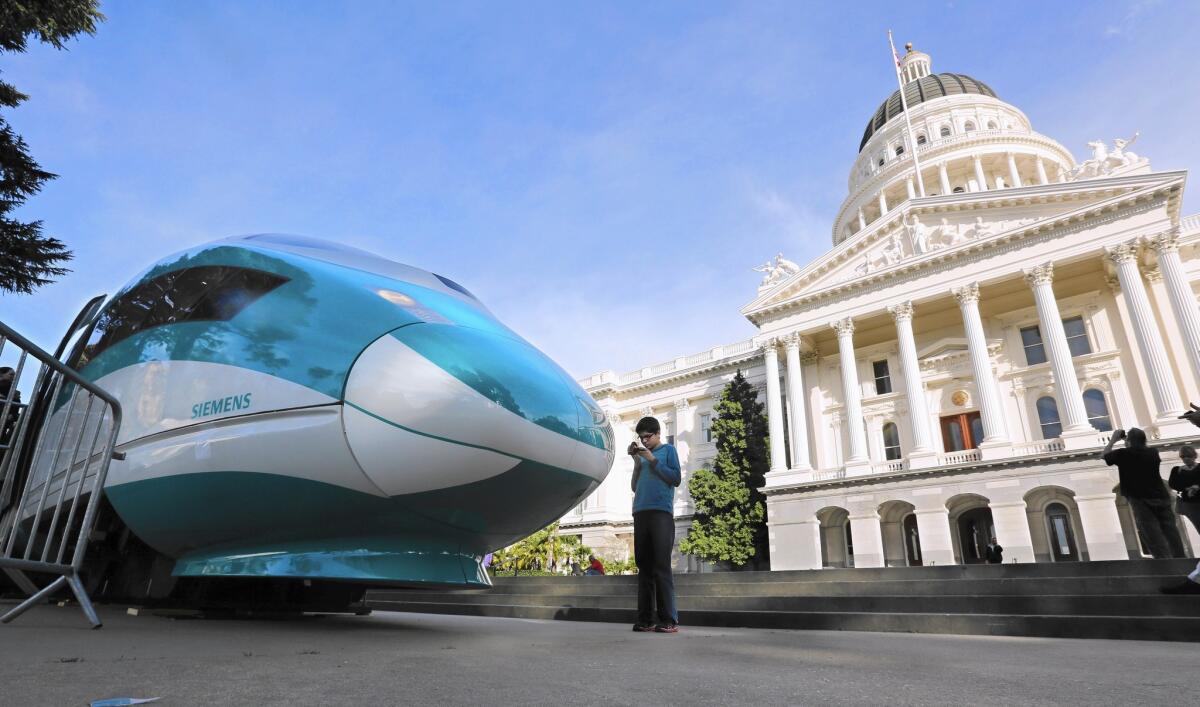Bullet train faces new scrutiny after release of report predicting higher costs

The Los Angeles to San Francisco bullet train is headed for new federal and state scrutiny following disclosure that the project’s lead contractor forecast significant cost increases that were not made public.
Rep. Jeff Denham (R-Turlock), chairman of the U.S. House rail subcommittee, said he plans to call hearings early next year to examine the project’s cost and the state’s failure to disclose the higher budget projections.
“We know it is going to have a significant increase in cost,” Denham said.
“It is doomed to be a failure,” Denham added. “California has always had the philosophy of build it and they will come. That is no way to run a business.”
Certainly before we start tunneling through mountains and destroying homes we need to know what the project is going to cost.
— Kristin Olsen, California Assembly Republican leader
Denham and 11 other House members demanded this month that the state’s main project management contractor release a 2013 cost estimate that shows a 31% increase for the project’s initial operating segment from Burbank to Merced.
State Assembly Speaker Toni Atkins (D-San Diego) said in a letter this month that her chamber “will be undertaking a broader range of oversight activities in 2016” that would subject the bullet train to an “enhanced process” and a public hearing.
Kristin Olsen, the California Assembly Republican leader, said she is expecting a hearing early next year, the first legislative oversight of the project in several years. The timing is crucial because Olsen said she expects the rail authority to ask for additional funding, given that it has not secured enough money to build even a partial system.
“The lack of transparency involving money on a project this large is very disturbing,” Olsen said. “Certainly before we start tunneling through mountains and destroying homes we need to know what the project is going to cost.”
The Times reported Oct. 25 that a 2013 report by Parsons Brinckerhoff, the project’s main management contractor, projected a 31% cost increase to build an initial segment from Burbank to Merced and an overall 5% increase in the full Los Angeles to San Francisco system.
The California High-Speed Rail Authority has dismissed the cost projection. Rail authority Chairman Dan Richard said in a letter to Atkins that a $68-billion estimate, which the authority used for its 2014 business plan, was backed up by scores of documents and analyses.
But a separate letter the rail authority issued last week contains a different explanation. It says the $68-billion estimate was essentially based on projections made in 2012.
In responding to a Public Records Act request from Bay Area attorney Jason Holder for documents substantiating the $68-billion estimate, the agency wrote: “The capital cost source document for the 2014 Business Plan is the 2012 Business plan. For the 2014 Business Plan, dollar amounts from the 2012 Business Plan were adjusted for inflation.”
The 2014 business plan projected a small decrease in costs, from $68.4 billion to $67.6 billion. The California Legislature, pleased that the costs had not risen from 2012 to 2014, voted four months later to approve additional funding for the project, allocating 25% of future carbon fees to the effort.
The letter sent to Holder aligns with statements officials close to the project made to The Times. Those officials said that after Parsons Brinckerhoff projected the higher costs, the rail authority told the company to adjust its calculations so they conformed with the 2012 estimate.
Holder, who represents opponents of the project, provided a copy of the letter to The Times.
Olsen, the Assembly’s minority leader, said rail authority statements raise additional concerns. “They don’t seem to be consistent in my view at all,” she said.
The rail authority has declined to identify the scores of documents that Richard said substantiates the lower cost estimate. The agency responded to questions about the matter by referring The Times to the letter it sent to Atkins. The authority would not explain differences in the letters to Atkins and Holder.
Rail authority officials say they believe they can hold the costs below $68 billion and note that two contracts for work in the Central Valley came in below state estimates.
The cost of the high-speed system is politically sensitive. Public opinion polls show that public support has dropped as costs have risen. The $68-billion estimate is more than double the projected cost at the time voters approved a $9-billion bond in 2008 to pay a portion of the costs.
The Parsons Brinckerhoff estimate was produced by a team of engineers and presented to the rail authority in October 2013. The firm estimated construction costs would increase 31% for the Burbank to Merced link, which involves the most complicated tunneling project in the nation’s history. The cost for the entire project, scheduled for completion in 2028, will rise 5%, the contractor said.
The estimate was based on the lowest possible costs, including a prospective low cost Oak Creek route over the Tehachapi Mountains that is no longer under consideration.
Richard sharply disputed the significance of the Parsons Brinckerhoff report. He said it was a preliminary draft and still in development, “subject to review, clarification and refinement.” At a rail authority board meeting, Richard called The Times’ story about the higher estimate “bunk.”
Twitter: @RVartabedian
ALSO
Perspective: Being black is exhausting, and here’s why
Billionaire Sumner Redstone unable to make decisions, says lawsuit by ex-girlfriend
While other areas are bone dry, San Diego has too much water
More to Read
Sign up for Essential California
The most important California stories and recommendations in your inbox every morning.
You may occasionally receive promotional content from the Los Angeles Times.










